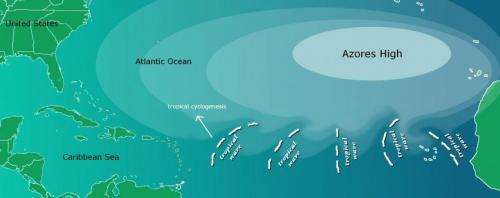April 29, 2014 report
Simulations suggest global warming will increase strength of winds associated with AEWs

(Phys.org) —A pair of researchers at Stanford University is predicting an increase in the strength of winds associated with African Easterly Waves (AEWs) over the next century due to global warming—if levels of CO2 pumped into the atmosphere continue at the current rate. In their paper published in Proceedings of the National Academy of Sciences, the team describes their findings after studying 17 global earth weather models and what it might mean for future hurricane development.
AEWs are tropical disturbances (bands of wind waves) that originate in the Atlantic Basin (the North and South Atlantic Oceans) and are thought to play a role in the development of tropical storms, including hurricanes (approximately 80 percent of tropical cyclones in the region have been linked to them). Climatologists studying current wind patterns are now attempting to understand what might occur as world temperatures rise due to greenhouse gas emissions. In this latest effort, researchers Christopher Skinner and Noah Diffenbaugh analyzed data from 17 global earth weather simulation models to discern if warming temperatures might have an impact on AWEs. Sadly, their research has revealed that the models (based on CO2 emissions doubling over the next century) suggest that warmer temperatures likely mean stronger winds associated AEWs. They note that that thus far, no evidence has been found that suggests stronger AEW winds would translate to more, stronger or bigger hurricanes, though many suspect that it's likely to be the case. Stronger AEWs, they point out, means more energy in the system, and such energy is usually dispersed via tropical storms. They also point out that currently, less than fifteen percent of AEW disturbances result in the formation of major tropical storms.
AEWs play another role in weather—prior research has shown that they are heavily involved in causing rain to fall in the Sahel and also tend to blow Saharan dust around on the African continent and into the atmosphere over the Atlantic Ocean. The models used by the researchers were not able to predict blowing dust patterns, but particulate matter in the atmosphere has previously been tied to the formation of tropical storms. Whether the impact of global warming on AEWs will mean more or less rain for Africa is still unclear.
More information: Projected changes in African easterly wave intensity and track in response to greenhouse forcing, Christopher Bryan Skinner, PNAS, 2014. DOI: 10.1073/pnas.1319597111
Abstract
Synoptic-scale African easterly waves (AEWs) impact weather throughout the greater Atlantic basin. Over the African continent, AEWs are instrumental in initiating and organizing precipitation in the drought-vulnerable Sahel region. AEWs also serve as the precursors to the most intense Atlantic hurricanes, and contribute to the global transport of Saharan dust. Given the relevance of AEWs for the climate of the greater Atlantic basin, we investigate the response of AEWs to increasing greenhouse gas concentrations. Using an ensemble of general circulation models, we find a robust increase in the strength of the winds associated with AEWs along the Intertropical Front in West Africa by the late 21st century of the representative concentration pathway 8.5. AEW energy increases directly due to an increase in baroclinicity associated with an enhanced meridional temperature gradient between the Sahara and Guinea Coast. Further, the pattern of low-level warming supports AEW development by enhancing monsoon flow, resulting in greater convergence and uplift along the Intertropical Front. These changes in energetics result in robust increases in the occurrence of conditions that currently produce AEWs. Given relationships observed in the current climate, such changes in the location of AEW tracks and the magnitude of AEW winds carry implications for the relationship between AEWs and precipitation in the Sahel, the mobilization of Saharan dust, and the likelihood of cyclogenesis in the Atlantic. Our results therefore suggest that changes in AEW characteristics could play a critical role in shaping the response of Atlantic basin climate to future increases in greenhouse gas concentrations.
Journal information: Proceedings of the National Academy of Sciences
© 2014 Phys.org



















